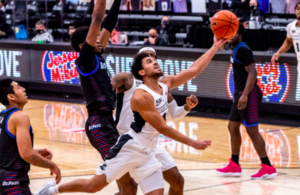- Friarbasketball.com has Moved to Substack!
- Season in Review: Jared Bynum
- Season in Review: Noah Horchler
- Digging in on Al Durham
- The Friar Podcast is a Must Listen
- PC vs. Xavier in 5 Minutes
- Defense is Failing Providence This Season
- UConn/Providence Video Preview with Kevin McNamara
- Jeff Battle and David Duke DePaul Presser
- Noah Horchler Emerging for the Friars
Welcome Back, UConn. Here’s What You’ve Missed
- Updated: June 30, 2020

Dear UConn,
It’s official, you are now in the Big East once again. The men’s college basketball landscape here has changed since you have been gone. Let’s take a look.
Strengthening Through the Midwest
It didn’t take Xavier, Creighton, and Butler long to adjust to life in the Big East. Just look at the win/loss records since the league was reconfigured:
- Villanova: 215-38 (103-23)
- Xavier: 163-82 (74-52)
- Creighton: 151-86 (69-57)
- Providence: 147-90 (70-56)
- Butler: 143-88 (64-62)
- Seton Hall: 142-88 (66-60)
- Marquette: 132-96 (60-66)
- Georgetown: 118-108 (51-75)
- St. John’s: 117-113 (45-81)
- DePaul: 88-139 (28-98)
Xavier has won the second most NCAA Tournament games in the league since 2014 (7), while Butler is third (5). Xavier reached the Elite Eight in 2017 (more on that later), while the Bulldogs won at least one tournament game in four consecutive seasons.
All three of these programs made a dent in the AP rankings. Xavier twice finished in the top 10 nationally in the final AP polls, while all three were ranked in the top 10 in more than one season. Xavier peaked at third in the country (2018), Butler fifth (2020), and Creighton seventh (2017 and 2020).
Nova’s Dominance
You’re probably well-versed in what Villanova has done over the past seven years, but as a refresher:
- National champions in 2016 and 2018
- A ridiculous 103-23 record in league play
- Four Big East Tournament championships
- Three AP All Americans
- The Big East Player of the Year in three of the past six years
- A 16-4 record in the NCAA Tournament since 2014
- Ranked #1 in the country in three different seasons
- Ranked in the top 10 nationally at some point in each of the past six seasons
- Ranked in the top ten nationally in the final AP poll in the first four years of the new conference
- 7 NBA draft picks since the Big East realigned
Faltering of Traditional Powers
When the non-football schools separated from their football brethren, there was a lot of chatter about how critical Georgetown and St. John’s would be to the future of the league. Conversely, the Big East has thrived while both programs faltered.
Georgetown’s fall has been particularly glaring. In the seven years prior to the beginning of the “new” Big East, the Hoyas won 30, 28, 16, 23, 21, 24, and 25 games. They were ranked in the top ten by the AP in all seven of the seasons prior to the start of the new league.
Since then Georgetown has had a winning record in the conference just once, which happened to be the only year they reached the NCAA Tournament since 2013. They are 24 (!) games under .500 in conference play since the basketball schools went their own way.
St. John’s sports the second worst overall win total and league record since realignment. They are 45-81 in Big East games and haven’t had a winning record in league play since 2015. The Johnnies reached the NCAA Tournament twice and lost their first game each time.
Marquette hasn’t held up their end either. They reached the NCAA Tournament in the eight seasons leading up to realignment. The Golden Eagles were a second weekend team in 2011, 2012, and 2013. Marquette has reached the tournament just twice in the past seven years, and hasn’t won a tourney game during that time.
Friars, Pirates the Benefactors
None of the seven Big East holdovers have benefitted more than Providence and Seton Hall. The Friars won their second Big East Tournament, and first since 1994, by defeating Creighton in 2014. PC’s 70 conference wins are good for third in the league since realignment. Providence also reached the Big East Tournament finals in 2018 before falling to Villanova in overtime. They have had a winning conference record in six of seven seasons. To put that in perspective, outside of Villanova, no other Big East team has had a winning conference record in more than four seasons during this time.
Seton Hall weathered a pair of 6-12 Big East seasons to kick off realignment, but haven’t had a losing record in the league since. Kevin Willard’s club won the 2016 Big East Tournament and finished in a three-way tie with Villanova and Creighton for first place in 2020.
Both schools have featured AP All Americans, with Kris Dunn making the 2nd team in 2016 and Myles Powell notching 1st team status last season. Each of these schools have reached the top 10 in the AP polls over the past five years.
The Friars were set to reach their sixth NCAA Tournament in seven years after winning 12 league games this year, while the Hall were on their way to five straight tourney appearances.
Postseason Struggles Beyond Villanova
Villanova’s two national titles obviously helped legitimize the league, but the Big East is desperate for other programs to enjoy March success.
Here are the schools’ NCAA Tournament records since 2014:
- Villanova: 16-4
- Xavier: 7-5
- Butler: 5-4
- Georgetown: 1-1
- Creighton: 1-3
- Seton Hall: 1-4
- Providence: 1-5
- Marquette: 0-2
- St. John’s: 0-2
- DePaul: 0-0
Coming off of an Elite Eight run in 2017, Xavier missed a golden opportunity a year later when they were a #1 seed and fell in the second round to Florida State. Villanova won the national title that year, and a second Big East team in a regional final would have further cemented the status of the league.
Butler reached the Sweet 16 in 2017 where they fell to North Carolina, and as mentioned before, they won a tournament game in four consecutive seasons.
Perhaps no club has been plagued by injuries more than Creighton. The Jays had the look of a Final Four contender in 2017 when star point guard Mo Watson was lost for the year due to a knee injury. They were 18-1 at the time.
For all of the strides Providence and Seton Hall have made, a combined 2-9 tournament record is an obvious stain. Both were carrying high hopes into this past March, as the Friars were on a six-game winning streak to close out the season and the Hall were as talented as any team in the Big East. Regardless, those tournament records will hang over both programs until they reach the second weekend of the tournament.
Georgetown hasn’t played in the tournament since splitting a pair of games in 2015, while Marquette has had a few very talented teams, but it hasn’t translated to March.
All Americans
The Big East has boasted at least one AP All American in six of the past seven seasons.
- 2014: Doug McDermott, Creighton (1st team)
- 2015: N/A
- 2016: Kris Dunn, Providence (2nd)
- 2017: Josh Hart, Villanova (1st)
- 2018: Jalen Brunson (1st) and Mikal Bridges (3rd), Villanova; Trevon Bluiett, Xavier (2nd)
- 2019: Markus Howard, Marquette (2nd)
- 2020: Markus Howard, Marquette (1st); Myles Powell, Seton Hall (1st)
Looking Ahead
Balance is the name of the game in the Big East. Villanova is the clear-cut top team in the revamped Big East, but there hasn’t been much separating Xavier, Butler, Creighton, Seton Hall, Providence, and Marquette from each other over the past five years. Georgetown and DePaul look to have significant rebuilds ahead of them, while Mike Anderson did enough in year one at St. John’s (with a lean roster) to scare people a bit. At the very least, the constant pressure of Anderson’s defense can make opponents look terrible for 40 minutes.
The league has had an all-for-one feel since ridding themselves of the football programs, and it will be interesting to see if that dynamic changes with the return of Connecticut. Coaches from more than one northeastern Big East school have noted how much more difficult their recruiting battles are bound to be with the Huskies back home.
The trimmed down league is far different than the one UConn was a part of — basketball is the unquestioned king in the Big East, and it just got a lot more interesting with the addition of the Huskies.




You must be logged in to post a comment Login